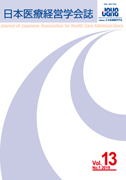Volume 13, Issue 1
Displaying 1-6 of 6 articles from this issue
- |<
- <
- 1
- >
- >|
Opening Article
-
2019Volume 13Issue 1 Pages 3
Published: 2019
Released on J-STAGE: September 13, 2019
Download PDF (147K)
Original Article
-
2019Volume 13Issue 1 Pages 5-10
Published: 2019
Released on J-STAGE: September 13, 2019
Download PDF (1085K) -
2019Volume 13Issue 1 Pages 11-17
Published: 2019
Released on J-STAGE: September 13, 2019
Download PDF (838K) -
2019Volume 13Issue 1 Pages 19-27
Published: 2019
Released on J-STAGE: September 13, 2019
Download PDF (904K) -
2019Volume 13Issue 1 Pages 29-36
Published: 2019
Released on J-STAGE: September 13, 2019
Download PDF (1108K)
Research Paper
-
2019Volume 13Issue 1 Pages 37-42
Published: 2019
Released on J-STAGE: September 13, 2019
Download PDF (1934K)
- |<
- <
- 1
- >
- >|
